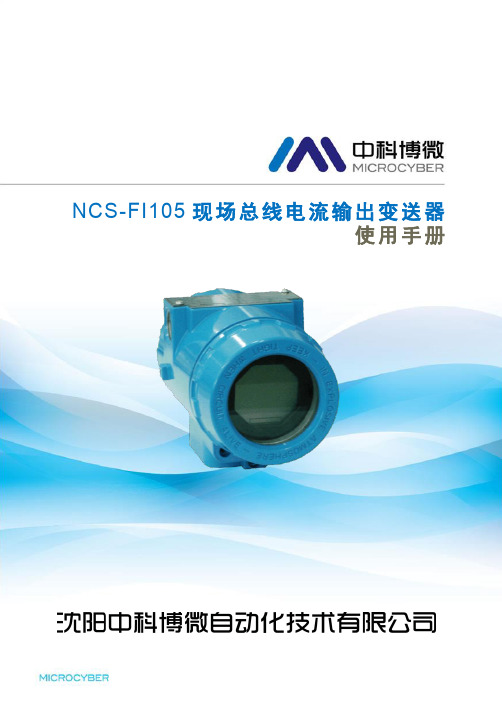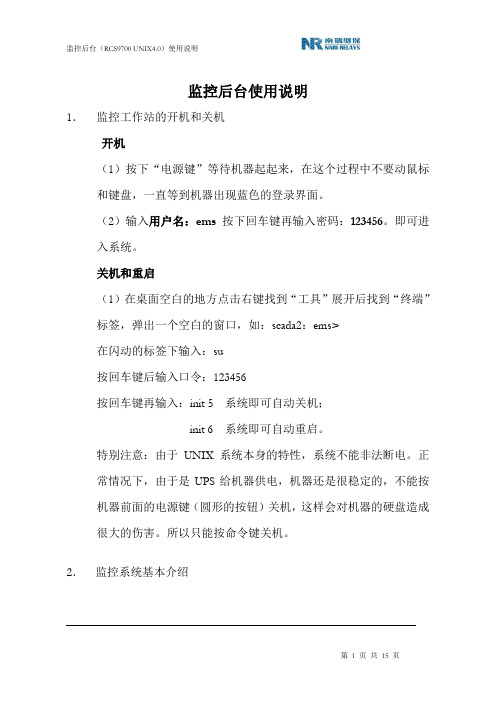NCS-LD105现场总线网关使用说明书
- 格式:doc
- 大小:783.50 KB
- 文档页数:8

LD-9115多线联动控制盘使用说明书1、概述LD-9115多线联动控制盘是专为消防控制系统中的重要设备:消防泵、排烟机、非消防强切、电梯归底等实施可靠控制而设计的。
本多线联动控制盘可与7800系列、9100系列报警控制器配合使用,且可根据实际工程需要灵活配置联动控制单元数量,组成专用多线联动控制盘。
LD-9115多线联动控制盘:由1块CPU控制单元和6块联动控制单元组成禁止允许命令 故障 动作 回授运行 故障 通讯自检消音复位命令 故障 动作 回授命令 故障 动作 回授命令 故障 动作 回授命令 故障 动作 回授命令 故障 动作 回授命令 故障 动作 回授命令 故障 动作 回授命令 故障 动作 回授命令 故障 动作 回授命令 故障 动作 回授命令 故障 动作 回授联动控制单元CPU控制卡12345671、运行灯 表示CPU卡正常状态2、故障灯 表示联动单元故障3、通讯灯 表示CPU卡与控制器通讯正常状态4、命令灯 正常巡检时闪亮表示该地址的联动单元状态正常自动启动时与动作灯同时恒亮表示该动作命令是由控制器发出的5、故障灯 表示该联动单元外线有断线或短路故障6、动作灯 表示联动单元动作输出,启动现场中间继电器7、回授灯 表示现场设备启动返回的信号每块LD-9115多线联动控制盘后可扩展1-21个联动控制单元每台控制器最多可带3块LD-9115多线联动控制盘此种方式联动组成最大消防联动配置为:[1块LD-9115C多线联动控制盘+21块LD-9115D联动控制单元]*32、额定使用条件温度: 0℃—40℃相对湿度 <95%(40℃±2℃)工作电压:DC24V使用电压范围:DC20V—DC28V3、功能3.1 自检按动自检键时,多线联动控制盘处于自检状态。
此时多线联动控制盘CPU控制单元的运行灯、故障灯、通讯灯及多线联动控制盘联动控制单元上的命令灯、故障灯、动作灯、回授灯点亮,并有故障音响发出。

Quick Start Guide00825-0100-4421, Rev DDMay 2023 Emerson Wireless Field LinkQuick Start Guide May 2023This guide provides basic guidelines for the Emerson Wireless Field Link. It does not provide instructions for diagnostics, maintenance, service, or troubleshooting. This guide is alsoavailable electronically on .WARNINGFailure to follow these installation guidelines could result in death or serious injury.Ensure only qualified personnel perform the installation.Explosions could result in death or serious injury.Installation of the transmitters in a hazardous environment must be in accordance with the appropriate local, national, and international standards, codes, and practices. Kindly review the Product Certifications section for any restrictions associated with a safe installation.Electrical shock could cause death or serious injury.Avoid contact with the leads and terminals. High voltage that may be present on leads cancause electrical shock.This device complies with Part 15 of the FCC Rules. Operation is subject to the following conditions:This device may not cause harmful interference.This device must accept any interference received, including interference that may causeundesired operation.This device must be installed to ensure a minimum antenna separation distance of 8-in. (20 cm) from all persons.ContentsWireless considerations (3)Physical installation (6)Verify operation (8)Reference information (9)Declaration of Conformity (11)Product certifications (14)/Rosemount1 Wireless considerations1.1 Power up sequenceTo achieve a simpler and faster network installation, verify thefollowing before the power modules are installed in any wireless fielddevices:•Emerson Wireless Field Link is installed and functioning properly•Wireless I/O is installed and functioning properly•Beginning with the closest, wireless field devices are powered upin order of proximity to the Wireless Field Link1.2 Mounting locationMount the Wireless Field Link in a location that allows convenientaccess to the host system network (wireless I/O) as well as thewireless field device network.Find a location where the Wireless Field Link has optimal wirelessperformance. Ideally this will be 15 to 25 ft. (4,6 to 7,6 m) above theground or 6 ft. (2 m) above obstructions or major infrastructure.A Control roomB GroundC Field linkD Mast or pipeE InfrastructureMay 2023Quick Start Guide Quick Start Guide3Quick Start Guide May 2023 1.3 Antenna positionPosition the antenna vertically, either straight up or straight down.Verify a distance of at least 3 ft. (1 m) is maintained from anylarge structure, building, or conductive surface to allow for clearcommunication to other devices.Figure 1-2: Antenna Position1.4 Conduit plugReplace the temporary orange plugs with the included conduit plugsusing approved thread sealant.Figure 1-3: Conduit PlugsAAA Conduit plug/Rosemount1.5 Intended useThe Wireless Field Link must be used in conjunction with a networkmanager or network Gateway. The Wireless Field Link then functionsas a translator between the wired network and a wireless fieldnetwork.Figure 1-4: Example System ArchitectureABC DEFA Host systemB Control networkC Network managerD Field linkE Wireless field networkF Wireless field devicesMay 2023Quick Start Guide Quick Start Guide5Quick Start Guide May 2023 2 Physical installation2.1 Pipe mountingProcedure1.Insert larger U-bolt around 2-in. pipe/mast, through thesaddle, through the L-shaped bracket, and through the washerplate.e a 1/2-in. socket-head wrench to fasten the nuts to theU-bolt.3.Insert smaller U-bolt around base the Wireless Field Link andthrough the L-shaped bracket.e a 1/2-in. socket-head wrench to fasten the nuts to theU-bolt.Figure 2-1: Mounting2.2 Power and data wiringWARNINGThe 781 Wireless Field Link data communication terminals A (+) and B(-) must never be connected directly to a power supply. Doing so maydamage the device.After removing the terminal block cover, the communicationterminals (Data A and Data B) are on the left side of the terminalblock. Connecting these terminals to anything other than thecorresponding data terminals of the 1410S or 1410D Gateway maydamage the 781 Wireless Field Link.Procedure1.Remove housing cover labeled “Field Terminals.”/Rosemount2.Connect the positive power lead to the “+” power terminal and the negative power lead to the “–” terminal.3.Connect the Data + lead to the “A (+)” terminal and the Data –lead to the “B (–)” terminal.4.Plug and seal any unused conduit connections.5.Replace the housing cover.Figure 2-2: Emerson Wireless Field Link Terminal DiagramABCD2.3 GroundingGround the Wireless Field Link enclosure in accordance with national and local electrical codes. The most effective grounding method is a direct connection to earth ground with minimal impedance. Ground the Wireless Field Link by connecting the external ground lug to earth ground. The connection should be 1 Ω or less.May 2023Quick Start GuideQuick Start Guide 7Quick Start Guide May 2023 3 Verify operation3.1 Power-up sequenceUpon applying power to the Wireless Field link the LCD display meterwill activate and display a series of startup screen. The followingscreens are displayed during startup:1.Startup Screen 1 – All segments on2.Startup Screen 2 – Device identification3.Startup Screen 3 – Tag4.Startup Screen 4 – Status3.2 Normal operationAfter the initial startup screens are displayed, the Wireless Field Linkwill cycle through the following periodic screens:1.Electronics Temperature Screen2.Percent Range Screen3.Wired Interface Usage4.Radio Interface UsageThe Wireless Field Link continues to rotate through each periodicscreen through the course of normal operation. If any diagnosticor fault condition occurs, a corresponding diagnostics screen willappear./Rosemount4 Reference informationFigure 4-1: Emerson Wireless Field Link Terminal DiagramABCDNoteThe Emerson Wireless Field Link requires separate twisted shield pairs (four wires) for power and data.May 2023Quick Start GuideQuick Start Guide 9Quick Start Guide May 2023 Figure 4-2: Emerson Wireless Field Link Dimensional DrawingTable 4-1: Emerson Wireless Field Link Specificationsabove maximum ambient temperature./Rosemount5 Declaration of ConformityMay 2023Quick Start GuideQuick Start Guide 11Quick Start Guide May 2023/RosemountMay 2023Quick Start GuideQuick Start Guide13Quick Start Guide May 2023 6 Product certificationsRev 2.36.1 European Directive InformationA copy of the EU Declaration of Conformity can be found at theend of the Quick Start Guide. The most recent revision of the EUDeclaration of Conformity can be found at .6.2 Ordinary Location CertificationAs standard, the transmitter has been examined and tested todetermine that the design meets the basic electrical, mechanical,and fire protection requirements by a nationally recognized testlaboratory (NRTL) as accredited by the Federal Occupational Safetyand Health Administration (OSHA).6.3 Installing in North AmericaThe US National Electrical Code® (NEC) and the Canadian ElectricalCode (CEC) permit the use of Division marked equipment in Zonesand Zone marked equipment in Divisions. The markings must besuitable for the area classification, gas, and temperature class. Thisinformation is clearly defined in the respective codes.6.4 USAI5 USA Intrinsic SafetyCertificate80011697Markings Class I, II, III Division 1 Groups A, B, C, D, E, F, G T4; ClassI, II, III Division 2, Groups A, B, C, D, F, G T4 T4(-40 °C ≤ T a≤ +70 °C); Class I Zone 0, AEx ia IIC T4 Ga; Class I Zone 2,AEx ic IIC T4 Gc; Zone 21 AEx ia IIIC T90 °C Db; Zone 22AEx ic IIIC T90 °C DcStandards FM 3600:2011, FM 3610:2018, FM 3611:2018, ANSI/UL60079-0:2019, ANSI/UL 60079-11:2014Warnings/Conditions of Acceptability1.Installed as per. Control drawing 01410-1300 for Hazardousand Non-Hazardous areas.2.Must be installed with a Resistive Barrier./RosemountMay 2023Quick Start Guide3.The plastic enclosure may constitute a potential electrostaticignition risk and must not be rubbed or cleaned with a drycloth.4.The measured capacitance between the equipment enclosureand metallic conduit adapter is 21pF. This must be consideredonly when the Model 781S is integrated into a system wherethe process connection is not grounded.6.5 CanadaI1 Canada Intrinsic SafetyCertificate80011697Markings Class I, II, III Division 1 Groups A, B, C, D, E, F, G T4; ClassI, II, III Division 2, Groups A, B, C, D, F, G T4 T4(-40 °C ≤ T a≤ +70 °C); Ex ia IIC T4 Ga; Ex ic IIC T4 Gc; Ex ia IIIC T90 °CDb; Ex ic IIIC T90 °C DcStandards CAN/CSA C22.2 No 60079-0:2019, CAN/CSA C22.2 No.60079-11:2014, CSA C22.2 No.213 – 2017Warnings1.Installed as per. Control drawing 01410-1300 for Hazardousand Non-Hazardous areas.2.Must be installed with a Resistive Barrier.3.The plastic enclosure may constitute a potential electrostaticignition risk and must not be rubbed or cleaned with a drycloth.4.The measured capacitance between the equipment enclosureand metallic conduit adapter is 21pF. This must be consideredonly when the Model 781S is integrated into a system wherethe process connection is not grounded.6.6 EuropeI1 ATEX Intrinsic SafetyCertificate Baseefa11ATEX0059XStandards EN IEC 60079-0:2018, EN 60079-11: 2012Markings II 1 G Ex ia IIC T4 Ga, T4(–40 °C ≤ T a≤ +70 °C)Quick Start Guide May 2023Special Conditions for Safe Use (X)1.The plastic antenna may present a potential electrostaticignition hazard and must not be rubbed or cleaned with a drycloth.2.The Rosemount 781 enclosure is made of aluminum alloy andgiven a protective paint finish; however, care should be takento protect it from impact or abrasion if located in a zone 0environment.3.The apparatus is not capable of withstanding the 500 Visolation test required by EN 60079-11. This must be taken intoaccount when installing the apparatus.6.7 InternationalI7 IECEx Intrinsic SafetyCertificate IECEx BAS 11.0028XStandards IEC 60079-0: 2011, IEC 60079-11: 2011Markings Ex ia IIC T4 Ga, T4(–40 °C ≤ T a≤ +70 °C)Special Conditions for Safe Use (X)1.The plastic antenna may present a potential electrostaticignition hazard and must not be rubbed or cleaned with a drycloth./RosemountMay 2023Quick Start Guide2.The Rosemount 781 enclosure is made of aluminum alloy andgiven a protective paint finish; however, care should be takento protect it from impact or abrasion if located in a zone 0environment3.The apparatus is not capable of withstanding the 500 Visolation test required by EN 60079-11. This must be taken intoaccount when installing the apparatus.6.8 EAC – Belarus, Kazakhstan, RussiaIM (EAC) Intrinsic SafetyCertificate RU C-US.Gb05.B.00643Markings0Ex ia IIC T4 Ga XSpecial Conditions for Safe Use (X)1.See certificate for special conditions.6.9 JapanI4 CML Intrinsic SafetyCertificate CML20JPN2401XMarkings Ex ia IIC T4 Ga (-40 °C ≤ T a≤ +70 °C), Ex ic IIC T4 Gc (-40°C ≤ T a≤ +70 °C)Special Conditions for Safe Use (X)See certificate.6.10 BrazilI2 INMETRO Intrinsic Safety (Rev 1 Only)Certificate UL-BR 20.1568XQuick Start Guide17Quick Start Guide May 2023 Markings Ex ia IIC T4 Ga (-40 °C ≤ T a≤ +70 °C), Ex ic IIC T4 Gc (-40°C ≤ T a≤ +70 °C)Standards ABNT NBR IEC 60079-0:2013, ABNT NBR IEC60079-11:2013Special Conditions for Safe Use (X)See certificate.6.11 ChinaI3 NEPSI本质安全证书GYJ20.1394X(CCC 认证)所用标准GB3836.1 – 2010, GB3836.4 – 2010, GB3836.20-2010标志Ex ia IIC T4 Ga特殊使用条件(X)1.产品外壳含有轻金属,用于0区时需注意防止由于冲击或摩擦产生的点燃危险。

NCS-FI105现场总线电流输出变送器使用手册警告1.变送器应安装在干燥的环境下,切忌雨水冲刷。
在恶劣环境下,应使用变送器保护箱。
2.禁止用户自行拆装变送器。
3.通电时,不得在爆炸性/易燃性环境下拆卸变送器表盖。
4.请用户自行检查变送器供电电压是否符合使用手册中的供电电压要求。
5.变送器外接地螺钉应可靠与大地连接。
公司简介沈阳中科博微自动化技术有限公司是由中国科学院沈阳自动化研究所发起创建的一家高新技术企业,主要从事网络化控制系统、工业通信及仪表、汽车电子产品的研究、开发、生产和应用。
中科博微承担了多个国家科技重大专项、国家高技术研究发展计划(863计划)、智能制造装备发展专项等国家科技计划项目,是国家网络化控制系统工程研究中心建设依托单位。
中科博微成功地开发了国内第一个通过国际认证的现场总线协议主栈、第一个通过国家认证的现场总线仪表、国内第一个通过德国TüV认证的安全仪表,与其它单位共同主持了制定国内第一个工业以太网协议标准EPA、第一个工业无线通信协议标准WIA-PA,并成为IEC 国际标准。
中科博微的产品和技术曾荣获国家科技进步二等奖两项、国家科技发明奖一项、中国科学院科技进步一等奖一项、辽宁省科技进步一等奖一项,产品出口欧美等发达国家,美国Emerson、瑞士Mettler Toledo等业内顶尖企业都在其产品中采用了博微的关键技术或关键部件,北京奥运会、上海世博会、广州亚运会的电动公交车都采用了博微电控产品,成功完成了200多项大型自动化工程项目。
中科博微成功通过了ISO9001:2008质量管理体系认证和汽车行业的ISO/TS16949质量体系认证。
优秀的研发团队,丰富的自动化工程设计与实施经验,业界领先的产品,庞大的市场网络,优秀的企业文化,都为公司的创业和持续发展奠定了坚实基础。
承载员工理想,创造客户价值,促进企业发展。
承载员工理想,创造客户价值,促进企业发展。
目录一、概述 (1)二、安装 (2)2.1变送器安装 (2)2.2接线 (3)三、工作原理与结构 (5)四、NCS-FI105F变送器配置 (9)4.1拓扑连接 (9)4.2功能块 (10)4.3功能配置 (11)4.4跳线配置 (15)五、NCS-FI105P变送器配置 (17)5.1拓扑连接 (17)5.2功能块 (18)5.3功能配置 (18)5.4跳线配置 (25)六、现场调校 (27)6.1磁棒操作说明 (27)6.2NCS-FI105F变送器现场调校 (29)6.3NCS-FI105P变送器现场调校 (32)6.4恢复仪表数据到出厂值 (35)七、维护 (36)八、技术规格 (38)8.1基本参数 (38)8.2技术指标 (38)8.3物理特性 (39)一、概述NCS-FI105变送器是将现场总线信号转换到传统模拟量的设备,可以接收现场总线信号,并转换成四个通道的4~20mA模拟信号。

监控后台使用说明1.监控工作站的开机和关机开机(1)按下“电源键”等待机器起起来,在这个过程中不要动鼠标和键盘,一直等到机器出现蓝色的登录界面。
(2)输入用户名:ems 按下回车键再输入密码:123456。
即可进入系统。
关机和重启(1)在桌面空白的地方点击右键找到“工具”展开后找到“终端”标签,弹出一个空白的窗口,如:scada2:ems>在闪动的标签下输入:su按回车键后输入口令:123456按回车键再输入:init 5 系统即可自动关机;init 6 系统即可自动重启。
特别注意:由于UNIX系统本身的特性,系统不能非法断电。
正常情况下,由于是UPS给机器供电,机器还是很稳定的,不能按机器前面的电源键(圆形的按钮)关机,这样会对机器的硬盘造成很大的伤害。
所以只能按命令键关机。
2.监控系统基本介绍(1)RCS9700监控系统在正常运行时,屏幕下方为监控系统任务栏,最左端为“开始”按钮,其中包含有“程序”、“设置”和“退出”几个基本菜单,、(2)“程序”菜单下是各个应用程序的快捷链接,这些快捷链接同时也将在“开始”按钮右侧以快捷目录的形式出现,点击后经过用户权限校验即可进入相关应用程序,各个工作站因为职能不同,可能配置的应用程序也有不同;(3)“设置”菜单中包含有“程序菜单设置”(用来修改编辑“开始”菜单中的各个项目)、“系统参数设置”(用于设置监控系统的一些基本参数)、“界面设置”(用于设置监控系统显示的相关参数)、“量测信息设置”和“状态信息设置”(分别用于设置系统任务栏中所显示系统信息的数值量和状态量)。
(1)右端为登陆用户名及时钟显示,最右端的箭头为隐藏按钮,点击可隐藏系统任务栏;(2)对于两台配置有双显示器的操作员站,在登陆用户名下方有“屏幕切换按钮”,点击该按钮可控制应用程序的画面在哪个显示器上显示,0屏幕为左侧显示器,1屏幕为右侧显示器。
(3)监控系统任务栏的上方为图形显示界面,用以显示主接线图等监控画面,窗口最小化后为桌面上一个蓝色球型图标,单击该图标即可恢复窗口正常大小;如将图形显示界面关闭可通过系统任务栏中“监控”目录下的快捷链接重新进入相应监控画面。

中科博微NCS-IF105现场总线电流输入变送器
佚名
【期刊名称】《中国仪器仪表》
【年(卷),期】2012(000)012
【摘要】NCS—IF105变送器是将传统模拟量转换到现场总线的智能设备,可以接收4个通道0-20mA或4-20mA模拟信号,
【总页数】1页(P44-44)
【正文语种】中文
【中图分类】TP212
【相关文献】
1.初谈混合式智能变送器与现场总线型全数字智能变送器(一) [J], 赵为民
2.直流电流变送器输入回路保护探讨 [J], 黎志;孙佳义;林昱;侯应权
3.圣斯尔推出穿孔式交流微电流隔离变送器 [J], 无
4.霍尼韦尔推出离散输入变送器,丰富其无线产品线--XYR6000离散输入变送器能够有效降低成本,提升工厂生产数据收集效率 [J], 无
5.穿孔式交流微电流隔离变送器 [J],
因版权原因,仅展示原文概要,查看原文内容请购买。

快速安装指南00825-0106-4421, D C版2020年9月艾默生™智能无线现场链接2020 年 9 月2快速安装指南本指南提供智能无线现场连接的基本安装说明,不提供诊断、维护、检修或故障排查的说明。
本指南的电子版本也可从 获得。
警告不遵守这些安装准则可能会导致严重的人身伤害甚至死亡。
⏹确保仅由取得相关资质的人员进行安装。
爆炸可能会导致死亡或严重伤害。
⏹在易爆环境中安装本变送器时,请务必遵守适用的当地、国家和国际标准、规范及规程。
请核对产品证书一节中是否有与安全安装相关的任何限制。
触电可能会导致死亡或严重伤害。
⏹应避免接触引线或接线端子。
导线上可能存在的高电压会造成电击。
本设备符合 FCC 规范的第 15 部分的规定。
设备操作应符合下列条件:⏹本设备不会导致有害干扰。
⏹本设备必须接受任何接收到的干扰,包括可能会导致非预定操作的干扰。
⏹安装本设备时,必须确保天线与所有人员间的最小间隔距离为 20 厘米 (8 英寸)。
目录无线设备安装注意事项 . . . . . . . . . . . . . . . . . . . . . . . . . . . . . . . . . . . . . . . . . . . . . . . . . . . . . . 3物理安装 . . . . . . . . . . . . . . . . . . . . . . . . . . . . . . . . . . . . . . . . . . . . . . . . . . . . . . . . . . . . . . . . . . . 5验证操作 . . . . . . . . . . . . . . . . . . . . . . . . . . . . . . . . . . . . . . . . . . . . . . . . . . . . . . . . . . . . . . . . . . . 7参考信息 . . . . . . . . . . . . . . . . . . . . . . . . . . . . . . . . . . . . . . . . . . . . . . . . . . . . . . . . . . . . . . . . . . . 8订购信息 . . . . . . . . . . . . . . . . . . . . . . . . . . . . . . . . . . . . . . . . . . . . . . . . . . . . . . . . . . . . . . . . . . 10产品认证 . . . . . . . . . . . . . . . . . . . . . . . . . . . . . . . . . . . . . . . . . . . . . . . . . . . . . . . . . . . . . . . . . . 11快速安装指南32020 年 9 月无线设备安装注意事项上电次序在任何无线现场设备中安装电源模块之前,应安装好智能无线现场链接和无线 I/O ,并确保它们能正常工作。
NCS使用手册目录第一章安装 (4)NCS的安装和连接 (4)NCS-NCW或NCS-NCF接口卡 (4)连接NCS计算机 (5)PC配置 (5)软件 (5)安装NCS应用软件 (6)安装打印机 (6)运行NCS应用程序 (7)NCS图形用户界面 (7)NCS主窗口 (7)标题栏 (8)菜单栏 (8)平面图显示区 (9)总貌图显示区 (9)事件窗口 (9)已确认事件窗口 (9)屏幕导航工具栏 (9)时间和日期显示区 (10)LOGO显示区 (10)报警/故障/监视/安全标识栏 (10)命令栏 (10)当前操作员提示区 (11)第二章操作 (12)正常操作 (12)自动导航 (12)故障 (12)报警 (13)操作菜单 (13)“文件”菜单项 (14)“操作员”菜单项 (14)“动作”菜单项 (15)“察看”菜单项 (17)“画面巡视”菜单项 (19)读状态/程序 (20)AM2020和AFP-400的读状态画面 (20)NFS-3030和NFS-640的读状态画面 (23)第三章历史记录管理器 (26)NCS历史记录管理器的操作 (26)存储的历史文件 (26)操作员列表 (27)事件数 (28)定制过滤器 (28)可见信息栏 (29)打印 (29)历史记录备份 (30)第一章安装NCS的安装和连接Notifier的网络显示控制器NCS是一台可以用文字和图形方式显示网络上所有事件和点的高性能计算机。
NCS应用在NOTI∙FIRE∙NET TM网络中,运行在界面友好的Windows环境下。
NCS-NCW或NCS-NCF接口卡NCS通过NCS-NCW或NCS-NCF接口卡与NOTI∙FIRE∙NET TM网络通讯。
NCS-NCW以屏蔽双绞线为网络介质,NCS-NCF以光纤为网络介质。
图1.1为两种接口卡的配置示意图。
警告:接触接口卡前必须戴上防静电护腕以免静电损坏接口卡!!!接网络接网络PCI接口电池(使用前移去绝缘垫片)图1.1 NCS-NCW和NCS-NCF接口卡蜂鸣音:NCS应用软件没有正确运行或掉电时,会出现“嘟、嘟”蜂鸣音。
NCS-FI105现场总线电流输出变送器
NCS-FI105变送器是将现场总线信号转换到传统模拟量的
设备,可以接收现场总线信号,并转换成四个通道的4~20mA 模
拟信号。
NCS-FI105是现场总线系统与控制阀门或其它执行器间
的转换器。
NCS-FI105变送器是符合FF /PA 现场总线协议的智能仪表,
可以与多个FF /PA 设备互连。
在NCS-FI105变送器中,集成了丰
富的功能模块,既可实现一般的检测功能,也可以实现复杂的控
制策略,用户可以根据要求和具体应用环境选取不同的功能块,以实现不同的功能。
主要特点
⏹ 优异的性能
——高精度:±0.05%满量程
——低温度漂移:<50ppm /℃
⏹ 多通道
——支持4通道电流输出
⏹ 多协议支持
——可支持FF 、PA 协议
技术特性
⏹ 性能指标
结构参数
沈阳中科博微自动化技术有限公司。
NCS-BP105现场总线电源调节器
NCS-BT105现场总线终端匹配器
现场总线电源调节器(以下简称总线电源)适用于Foundation Fieldbus及Profibus PA 现场总线控制系统,向总线供电型设备提供电源。
总线电源采用有源阻抗控制方式,与简单的无源方案相比可大大提高带载能力;同时提供了均匀的阻抗特性,与终端匹配器配合,可再现完美的总线信号。
总线电源面板上有两个LED分别用于电源指示和过流指示,方便维护。
总线电源内部提供了一个可选择的终端匹配器,当不使用总线电源冗余时,可采用内部的终端匹配器。
总线电源可以支持电源冗余,当采用两个总线电源冗余连接时,可以进一步提高系统的可靠性。
现场总线终端匹配器与总线电源配套使用,安装在总线的末端,实现信号的阻抗匹配功能,同时完成电流信号到电压信号的转换。
主要特点
●总线供电,适用于符合IEC 61158-2标准的现场总线
●符合FF-831总线电源测试规范
●过流保护及指示
●集成终端匹配器,可选
●支持冗余连接
●有源阻抗控制方式
●随动电压输出方式,可满足长距离供电要求
●抗强电磁干扰,保护总线设备
基本参数
沈阳中科博微自动化技术有限公司。
NCS-LD105现场总线网关
使用说明书
一.概念
NCS-LD105现场总线网关是连接FF HSE现场总线和FF H1现场总线的网关设备。
一台网关最多可以连接四个H1网段,同时具有网桥功能。
NCS-LD105现场总线网关可用于各种采用FF H1现场总线设备的控制系统当中,可将FF H1总线设备无缝集成到以太网网络中,扩展FF H1应用。
用户可以通过基于以太网的组态软件,完成对整个网络的组态、控制回路组态、控制逻辑组态、功能块连接、报警趋势组态、控制应用下载等功能。
二.产品的型号规格
通道数(1、2、4)
总线类型(F— H1;H— HSE;D—DP)
厂商名
现场总线网关
网络化控制系统
注:DP总线网关暂不支持。
三.主要技术参数
3.1基本参数
3.2功能特性
3.3物理特性
3.4外型尺寸
四.结构与工作原理
4.1 产品结构说明
现场总线网关硬件上由两部分组成,控制卡和通信卡。
控制卡由EEROM、CPU、FLASH、RAM、以太网芯片等组成。
通信卡包含电源部分及最多4个H1
接口芯片。
控制卡与通信卡通过内部总线通信。
图1 结构示意图
4.2 工作原理简述
CPU通过对以太网芯片及H1接口芯片的操作实现HSE(以太网)总线与H1总线的信息通讯。
五.调整和校验
无。
六.安装、使用和维护
6.1 安装
网关的各种接口及指示灯如下图所示:
图2 接口及指示灯图
电源指示:亮—表示电源正常;灭—表示未供电或电路故障; 程序状态指示:未使用;
H1总线发送指示:向H1总线发送数据时闪烁;
以太网连接指示:亮—表示网线连接无误;灭—表示硬件故障或网线连接有问题;
以太网活动指示:当以太网有数据包时,此灯闪烁。
电源接口:外接电源通过附带的一个4针绿色端子与电源接口相连。
以太网接口:与以太网网线直接相连。
H1总线接口:与H1总线连接,各引脚信号含义如下:
6.2 使用
与其他现场总线仪表、智能分布控制装置、组态软件配合使用。
请参考《FF 组态软件用户手册》了解网关的使用方法。
6.3 维护
1. 故障检查
•电源灯不亮
检查电源是否供电,及供电电压是否正确。
•不能上线
检查以太网连接指示是否亮,不亮请检查以太网连接主机IP是否与网关在同一网段。
•检测不到与网关相连的仪表
首先检查仪表及仪表连接是否正确
检查H1接口连接是否正确
2. 日常维护只限于清洁设备。
3. 维修:发现故障,请返厂维修。